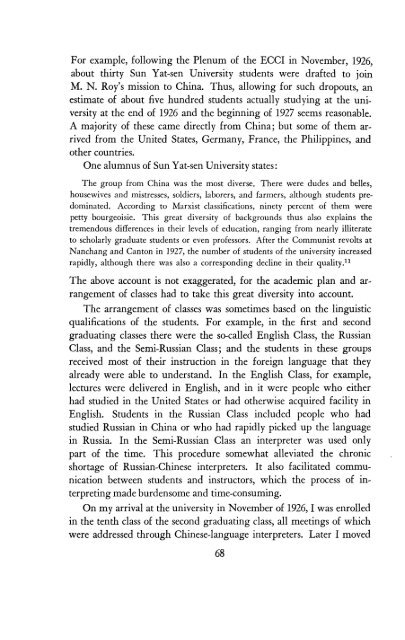Sun Yat-sen University in Moscow and the Chinese Revolution - KU ...
Sun Yat-sen University in Moscow and the Chinese Revolution - KU ...
Sun Yat-sen University in Moscow and the Chinese Revolution - KU ...
You also want an ePaper? Increase the reach of your titles
YUMPU automatically turns print PDFs into web optimized ePapers that Google loves.
For example, follow<strong>in</strong>g <strong>the</strong> Plenum of <strong>the</strong> ECCI <strong>in</strong> November, 1926,<br />
about thirty <strong>Sun</strong> <strong>Yat</strong>-<strong>sen</strong> <strong>University</strong> students were drafted to jo<strong>in</strong><br />
M. N. Roy's mission to Ch<strong>in</strong>a. Thus, allow<strong>in</strong>g for such dropouts, an<br />
estimate of about five hundred students actually study<strong>in</strong>g at <strong>the</strong> university<br />
at <strong>the</strong> end of 1926 <strong>and</strong> <strong>the</strong> beg<strong>in</strong>n<strong>in</strong>g of 1927 seems reasonable.<br />
A majority of <strong>the</strong>se came directly from Ch<strong>in</strong>a; but some of <strong>the</strong>m arrived<br />
from <strong>the</strong> United States, Germany, France, <strong>the</strong> Philipp<strong>in</strong>es, <strong>and</strong><br />
o<strong>the</strong>r countries.<br />
One alumnus of <strong>Sun</strong> <strong>Yat</strong>-<strong>sen</strong> <strong>University</strong> states:<br />
The group from Ch<strong>in</strong>a was <strong>the</strong> most diverse. There were dudes <strong>and</strong> belles,<br />
housewives <strong>and</strong> mistresses, soldiers, laborers, <strong>and</strong> farmers, although students predom<strong>in</strong>ated.<br />
Accord<strong>in</strong>g to Marxist classifications, n<strong>in</strong>ety percent of <strong>the</strong>m were<br />
petty bourgeoisie. This great diversity of backgrounds thus also expla<strong>in</strong>s <strong>the</strong><br />
tremendous differences <strong>in</strong> <strong>the</strong>ir levels of education, rang<strong>in</strong>g from nearly illiterate<br />
to scholarly graduate students or even professors. After <strong>the</strong> Communist revolts at<br />
Nanchang <strong>and</strong> Canton <strong>in</strong> 1927, <strong>the</strong> number of students of <strong>the</strong> university <strong>in</strong>creased<br />
rapidly, although <strong>the</strong>re was also a correspond<strong>in</strong>g decl<strong>in</strong>e <strong>in</strong> <strong>the</strong>ir quality. 11<br />
The above account is not exaggerated, for <strong>the</strong> academic plan <strong>and</strong> arrangement<br />
of classes had to take this great diversity <strong>in</strong>to account.<br />
The arrangement of classes was sometimes based on <strong>the</strong> l<strong>in</strong>guistic<br />
qualifications of <strong>the</strong> students. For example, <strong>in</strong> <strong>the</strong> first <strong>and</strong> second<br />
graduat<strong>in</strong>g classes <strong>the</strong>re were <strong>the</strong> so-called English Class, <strong>the</strong> Russian<br />
Class, <strong>and</strong> <strong>the</strong> Semi-Russian Class; <strong>and</strong> <strong>the</strong> students <strong>in</strong> <strong>the</strong>se groups<br />
received most of <strong>the</strong>ir <strong>in</strong>struction <strong>in</strong> <strong>the</strong> foreign language that <strong>the</strong>y<br />
already were able to underst<strong>and</strong>. In <strong>the</strong> English Class, for example,<br />
lectures were delivered <strong>in</strong> English, <strong>and</strong> <strong>in</strong> it were people who ei<strong>the</strong>r<br />
had studied <strong>in</strong> <strong>the</strong> United States or had o<strong>the</strong>rwise acquired facility <strong>in</strong><br />
English. Students <strong>in</strong> <strong>the</strong> Russian Class <strong>in</strong>cluded people who had<br />
studied Russian <strong>in</strong> Ch<strong>in</strong>a or who had rapidly picked up <strong>the</strong> language<br />
<strong>in</strong> Russia. In <strong>the</strong> Semi-Russian Class an <strong>in</strong>terpreter was used only<br />
part of <strong>the</strong> time. This procedure somewhat alleviated <strong>the</strong> chronic<br />
shortage of Russian-Ch<strong>in</strong>ese <strong>in</strong>terpreters. It also facilitated communication<br />
between students <strong>and</strong> <strong>in</strong>structors, which <strong>the</strong> process of <strong>in</strong>terpret<strong>in</strong>g<br />
made burdensome <strong>and</strong> time-consum<strong>in</strong>g.<br />
On my arrival at <strong>the</strong> university <strong>in</strong> November of 1926,1 was enrolled<br />
<strong>in</strong> <strong>the</strong> tenth class of <strong>the</strong> second graduat<strong>in</strong>g class, all meet<strong>in</strong>gs of which<br />
were addressed through Ch<strong>in</strong>ese-language <strong>in</strong>terpreters. Later I moved<br />
68

















